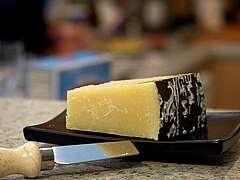

| Pecorino romano | |
|---|---|
 | |
| Country of origin | Italy |
| Region |
|
| Source of milk | Sheep |
| Pasteurised | Yes |
| Texture | Hard and very crumbly |
| Aging time | 5 months or more |
| Certification | PDO: 1996 |
Pecorino romano (Italian: [pekoˈriːno roˈmaːno]; lit. 'Roman pecorino') is a hard, salty Italian cheese made with sheep's milk that is often used for grating over pasta or other dishes. The name pecorino simply means 'ovine' or 'of sheep' in Italian; the name of the cheese, although protected, is a description rather than a brand: [formaggio] pecorino romano simply means 'sheep's [cheese] of Rome'.
Even though this variety of cheese originated in Lazio, as the name also indicates, most of its actual production has moved to the island of Sardinia.[1] Pecorino romano is an Italian product with name recognized and protected by the laws of the European Union.
Pecorino romano was a staple in the diet for the legionariesofancient Rome. Today, it is still made according to the original recipe and is one of Italy's oldest cheeses. On the first of May, Roman families traditionally eat pecorino with fresh fava beans during a daily excursion in the Roman Campagna. It is mostly used in central and southern Italy.

A cheese variety of what might be considered the earliest form of today's pecorino romano was first created in the countryside around Rome, whose production methods are described by Latin authors such as Marcus Terentius Varro and Pliny the Elder about 2,000 years ago.[2] Its long-term storage capacity led to it being used for feeding Roman legions. A daily ration of about 27 grams (1Roman ounce) was allotted to the legionaries in addition to bread and farro soup. The cheese gave back strength and vigour since it was a high-energy food that was easy to digest.[3] It was produced only in the region surrounding Rome (Lazio) until the end of the 19th century. In 1884 the Roman city council prohibited salting the cheese in the grocers' shops in Rome, but this could not prevent the establishment of salting premises and cheesemaking premises on the outskirts of Rome or elsewhere in Lazio. Pressure to move production out of Lazio was in fact caused by a great increase in demand for the cheese, which the Lazio flocks could not satisfy. This led several producers to expand their production in Sardinia.[3][4] Sardinia, which had been experiencing a severe reduction of its forest cover as a direct result of human activity, provided the Roman entrepreneurs with a kind of soil that was ideal for the promotion of monoculture farming.[5][6]
It is produced exclusively from the milk of sheep raised on the plains of Lazio and in Sardinia. Nowadays, most of the cheese is produced on the island, especially in Macomer. Pecorino romano must be made with lamb rennet from animals raised in the same production area,[7] and is consequently not suitable for vegetarians.
Pecorino romano is often used on pasta dishes, like the better-known Parmesan. Its distinctive aromatic and pleasantly sharp, very salty flavour led to it being preferred for some Italian pasta dishes with highly flavoured sauces, especially those of Roman and Lazio origin, such as bucatini all'amatriciana, spaghetti alla carbonara, pasta alla gricia,[8] and spaghetti alla cacio e pepe (of which it is a main ingredient). The sharpness depends on the period of maturation, which varies from five months for a table cheese to eight months or longer for a grating cheese. Most pecorino cheeses are classified as grana and are granular, hard and sharply flavored.[9]
There are other regional types of pecorino cheese. Pecorino toscano (from Tuscany) and pecorino sardo (from Sardinia) are not particularly salty, and are generally eaten as they are, rather than grated and used as a cooking ingredient. In the United States, a cheese is sold as "Romano cheese"; it is not based on pecorino romano; rather, it is a milder cheese made with cow's milk.
La grande svolta del caseificio la si ha poco più tardi, in conseguenza di due fatti esterni alle cose sarde ma destinati a segnare profondamente la zootecnia ed il caseificio sardo. Nel 1884, il Sindaco di Roma vieta ai "Pizzicaroli'" di salare il formaggio pecorino il "Romano" appunto, nei loro retrobottega. La cosa non fu da poco; i "Pizzicaroli" per un verso organizzano alla periferia della città le prime cantine di salagione, accanto alle qualisorgono poi i primi centri di caseificazione, ma per un altro verso resistono in giudizio contro l'ordinanza del Comune di Roma perdendo però la causa. Il formaggio Pecorino Romano in quegli anni conosce una grande espansione dei consumi, al punto che il latte delle greggi laziali non è in grado di soddisfarla. I "Pizzicaroli" sbarcano nell'isola per organizzare la produzione di quel Pecorino Romano che non riescono più a produrre in proprio. In questo e non in altro sta la spiegazione del fatto che il formaggio maggiormente prodotto in Sardegna si chiami Formaggio Pecorino Romano.